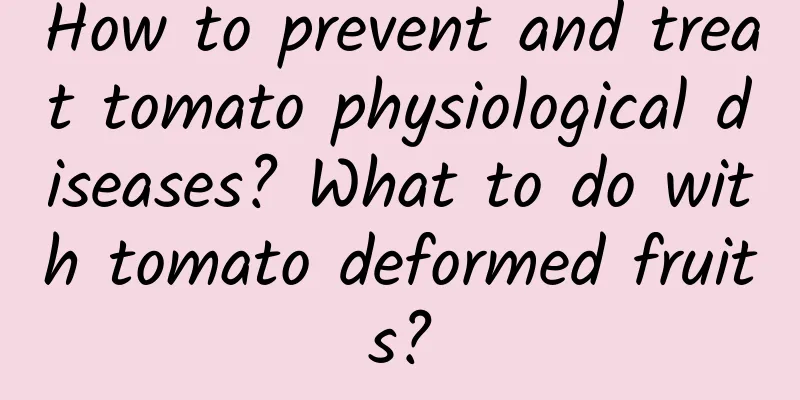How to prevent and treat tomato physiological diseases? What to do with tomato deformed fruits?

|
Here I will tell you how to prevent and treat physiological diseases of tomatoes: 1. Deformed FruitThere are three types. One is the deformed fruit. The structure of this deformed fruit has not changed much, but the shape is not round. Some are oval fruits, that is, due to the increase in carpels, their cross-section is oval; some become pointed fruits, that is, peach-shaped fruits. The number of carpels in the fruit is normal, but the navel is particularly protruding like a peach. The second is the tubercle fruit. There is a tubercle-like protrusion near the end of the sepals of the fruit, shaped like a nose, so it is called a nose-shaped tubercle. The third is the navel-cracked fruit. The peel at the navel part of the fruit cracks, so that the placenta tissue and seeds sometimes roll outward and expose. This navel-cracked fruit is often caused by the cracking of the pistil of the deformed flower. The formation of deformed fruits begins when the flower buds differentiate. When the flower buds differentiate, the temperature is low, the water, fertilizer, and light are insufficient, and the nutrition is malnourished, the flower buds are poorly differentiated, and deformed fruits such as pointed fruits with fewer ventricles are easily formed. If there is too much water and fertilizer, sufficient light, and vigorous stems and leaves during the flower bud differentiation period, and the temperature is low, the flower bud differentiation nutrients are excessive and the flower bud cells divide too vigorously, which is easy to form multi-carpel oval fruits or tumor-shaped fruits. In addition, if the concentration of growth stimulants is too high, it is easy to form pointed fruits; too dry or too wet soil affects the development of flower buds and is also easy to form deformed fruits. Preventing the production of deformed fruits must start from the seedling stage. During the seedling stage, pay attention to the control of environmental conditions such as temperature, light, water, and fertilizer, create conditions that are conducive to flower bud differentiation, and use growth stimulants appropriately to avoid or reduce the occurrence of deformed fruits. 2. Grain-shaped fruitThe fruit develops very slowly after it sets, and after maturity, it is as small as a cherry seed, which is called grain-shaped fruit or dead fruit. Grain-shaped fruit phenomenon occurs more frequently in tomato overwintering and early-maturing cultivation. The cause of its occurrence is poor pollination during the flowering period, low night temperature, insufficient light, and too little nutrient accumulation. After being treated with growth stimulants, the formation of abscission layer at the fruit stalk is inhibited. After the fruit sets, the photosynthetic product supply is too small to expand. Measures to prevent the occurrence of grain-shaped fruit are to spray one ten-thousandth of the natural brassica sucrassin-Shuofeng 481, improve environmental conditions such as temperature and light during the flowering period, enhance photosynthesis, and improve the nutrient supply of the fruit. 3. Stains and Brown HeartSpots are yellow or green patches in the fruit peel tissue. The appearance of spotted fruits is related to the growth density of seeds. When there are fewer seeds in the ventricle, the activity of hormones is reduced, and the soluble solids content in the juice is low, spots are more likely to appear. Measures to prevent the occurrence of spots are to strengthen fertilizer and water management and spray natural brassica oleracea-Shuofeng 481 at 1/10,000 liquid. Brown heart: The vascular bundle of the fruit turns brown, or the interior of the fruit turns gray-brown. Brown heart is generally caused by viruses, and there is also a physiological brown heart phenomenon. It is easy to occur under conditions of weak light, humid air and lack of potassium fertilizer. Measures to prevent brown heart are: pay attention to virus prevention and control, improve light conditions, properly ventilate and dehumidify, and increase potassium fertilizer. During the growth period, 0.2% liquid of high-energy red potassium can be sprayed on the roots 3-4 times. |
<<: How to prevent and control tomato bacterial wilt
>>: How to grow tomatoes? Tomato cultivation tips
Recommend
The efficacy and function of date kernels and the benefits of eating dates
Dates are called desert bread in daily life. They...
Nutritional value of peas
Today I will tell you about the nutritional value...
The benefits of drinking dried kumquat in water
Kumquat is a type of orange. Kumquat is a fruit r...
How to make delicious bowfish? Tips on how to make delicious bowfish
Gongyu is a specialty fish of Erhai Lake in Yunna...
How to make spicy and sour pickled radish strips
Hot and sour pickled radish strips are a very app...
How to propagate green radish? A tutorial on how to propagate green radish
The green foliage plant that everyone is most fam...
Nutritional value and efficacy of kelp
Kelp is one of the foods we often eat. Kelp conta...
How to make handmade noodles How to make handmade noodles
Noodles are a kind of food that we often eat. How...
How is the French Dassault Group? French Dassault Group reviews and website information
What is the website of the French Dassault Group? ...
How to identify the authenticity of jade? How to identify the authenticity of jade
Jade can be made into various ornaments and acces...
The efficacy and function of white lentil
Many people have eaten white lentils, but many pe...
Can corn silk help you lose weight? How to lose weight with corn silk
Corn silk is a thin thread-like substance on the ...
Types and methods of watermelon seeds
When we finish eating watermelon, we can keep the...
How to use banana peels for beauty How to use banana peels for beauty
We often eat bananas, and we usually peel and thr...
What is The Tamil Guardian like? The Tamil Guardian review and website information
What is the Tamil Guardian website? The Tamil Guar...









